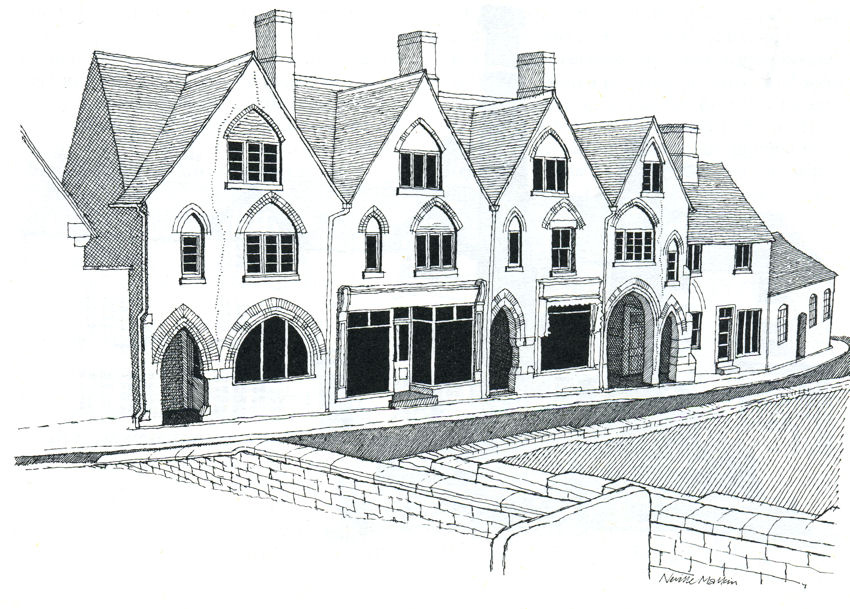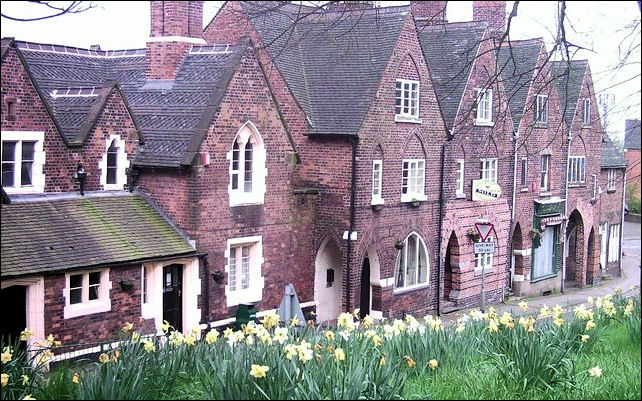|
|
|
![]() back to "The Grand Tour" index
back to "The Grand Tour" index
Neville Malkin's "Grand Tour" of the Potteries
buildings north of the Potteries
![]()
![]()
![]()
next: Saxon Crosses,
Sandbach
previous: St. Margaret's
Church,
Wolstanton
contents: index of buildings north of the Potteries
|
No 29 - Gothic Shops
and Houses, Audley
"The first building on the left is the school house (no. 14 Church Street) of what was at the time Audley Infants’ School. All of the buildings on the left hand side are recorded as having been built in 1855. They replaced a row of old houses and gardens which are shown on the 1837 Tithe Map of Audley (see maps). The large group of three storey Gothic-design shops and houses (nos. 8-12) along with the out-of-view smaller section (nos. 4-6) were designed by the architect William White. The building in the centre is Castle Hill farm in Nantwich Road. On the right are another group of shops (nos. 15-19). No. 17 was Audley’s first post office of the Penny Post era. These buildings back on to the area known as Church Bank. It was in this area that Audley village first developed, between Castle Hill and the parish church." The Changing Face of Audley Clive Millington
They appeared in the 11 August 1855 edition of The Builder (a weekly journal of the construction industry, founded in 1842 by the architect Joseph Hansom, who designed the Hansom cab). Extract:
Now a grade II listed building with the following description.....
By William White. Red brick (English and Flemish bonds) with some polychromy; plain tile roofs; brick off-ridge stacks. Simplified Gothic. 2 storeys and attic. 4 gabled units with a slightly lower house set back to the right. At ground level are 3 shops (Nos. 8, 10 and 12). In front of these there was originally an open arcaded passage of alternate narrow and wide pointed arches. The arches of No. 12, to the left, survive but modern shop fronts have been inserted in Nos. 8 and 10. Between the shops and the house (No.4) to the right is a similar but reversed pair of arches, the larger of which gives access to a passage leading to the rear. Casements to first floor and attic, all with pointed tympana; alternate large and small first floor windows repeating the ground floor arrangement of arches; the larger windows have 3 lights, the smaller are single lights. No. 8 has one late C19/early C20 sash window at first floor level. No. 4 has some inserted casements and a double sash beneath a pointed tympanum. The design for Nos. 4-12 Church street was illustrated in The Builder, 11th August 1855. B.o.E. p. 64." |

St. Margaret's Church,
Wolstanton
pen drawing by Neville Malkin -
March 1976

William White Buildings in
Church Street, Audley
The first building on the left is the school
house
Photo: © Deb Forster-Sharples 2004
licensed for further reuse
"Situated in the village of Audley is this
extraordinary row of Gothic shops and houses which were designed by
William White and featured in "The Builder" in 1855. They consist of
three shops, an archway and a house, built entirely from brick. The
design is reduced to essentials, has pointed arches of various sizes,
and no decoration or ornament except a little polychromy.
Unfortunately the 20th century has intruded, and two of the shops have
been fitted with characterless fronts, which is a great pity.
He left four sons but the first three died in quick succession, so Nicholas, the youngest, succeeded to the inheritance in 1283. After being summoned to Parliament in 1296-97, he was created Baron Audley of Heighley. He died in 1299 and his eldest son, Thomas, became 2nd Baron. Thomas died before he came of age and was succeeded by his brother, Nicholas, who left, at his death in 1316, a son, James, the 4th Baron. Edward III made James Governor of Berwick in 1343, and five years later created him one of the original Knights of the Garter. In 1356 James served under the Black Prince at the Battle of Poitiers and distinguished himself by his bravery. This hero of Poitiers died in 1386 and the barony passed to his son, Nicholas, who died without issue in 1392.
The title was forfeited but eventually restored to his son, John, by Henry VIII in 1513. On his death in 1559, the Barony went successively to his son, George, and his grandson, Henry, who married the daughter of Sir William Sneyd. Henry served in the Earl of Leicester's army in the Netherlands, and was made a Knight Banneret for his valour at the Battle of Zutphen in 1586. He died in 1595 and was succeeded by his son, George, who was made Governor of Utrecht by Queen Elizabeth. About 1600, George Touchet, 13th Baron Audley and later 1st Earl of Castlehaven, sold all his estates in Staffordshire, Cheshire and Shropshire, thereby severing all connections with the area from which this noble family had sprung."
|
next: Saxon Crosses, Sandbach
previous: St. Margaret's Church, Wolstanton
contents: index of buildings north of the Potteries
back to "The Grand Tour" index